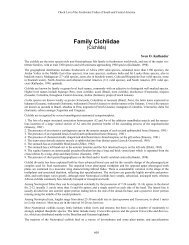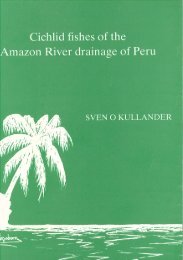Open Access PDF - Sven Kullander
Open Access PDF - Sven Kullander
Open Access PDF - Sven Kullander
You also want an ePaper? Increase the reach of your titles
YUMPU automatically turns print PDFs into web optimized ePapers that Google loves.
Diagnosis. Distinguished from all other species<br />
of Cichla by presence in adults of small light spots<br />
on pelvic and anal fins, and lower lobe of caudal<br />
fin. Similar to C. monoculus and C. pleiozona in<br />
possession of three dark vertical bars on side,<br />
presence of a pronounced occipital bar in large<br />
specimens, absence of black or ocellated markings<br />
laterally on head, and presence of irregular dark<br />
blotches on anterior abdominal side. Distinguished<br />
from C. pleiozona by less scales in a lateral<br />
row (76-83 vs. 84-93 in C. pleiozona) and<br />
typical absence of bar 4.<br />
Description. Refer to Figs. 28-32 for general shape<br />
and colour pattern, Table 16 for morphometrics,<br />
and Tables 2-10 for meristics.<br />
Adults relatively deep (depth 31.7-33.7 % SL,<br />
N = 6, 246-276 mm SL). Predorsal contour straight,<br />
smoothly arched anterior to dorsal fin, large males<br />
with indicated (MZUSP 38410) to pronounced (in<br />
holotype) nuchal elevation. Maxilla reaching to<br />
below middle of orbit. Lower jaw prognathous,<br />
articulation below posterior margin of orbit.<br />
Lateral line discontinuous on both sides in all<br />
specimens.<br />
Dorsal spines 3-6 or 4-6 longest; soft dorsal<br />
fin rounded, not quite reaching to caudal fin base;<br />
in large males subacuminate, reaching to or<br />
slightly beyond caudal fin base. Soft anal fin<br />
rounded, reaching beyond middle of caudal peduncle;<br />
in large males subacuminate, to caudal<br />
fin base. Caudal fin rounded, upper corner angled,<br />
lower corner rounded. Pectoral fin pointed, fourth<br />
ray longest, reaching halfway to end of anal fin<br />
base. Pelvic fin subacuminate, first or second ray<br />
Table 16. Morphometry of Cichla kelberi. Measurements are in percent of SL, except SL (in mm). Linear regression<br />
parameters calculated from original measurements in mm. HT, holotype (MZUSP 92397).<br />
N min max mean SD HT a b r<br />
SL (mm) 10 48.1 275.5 212.0 275.5<br />
Head length 10 31.9 35.3 33.4 1.03 33.1 0.596 0.330 0.997<br />
Snout length 10 10.2 12.1 11.5 0.55 11.6 –1.017 0.121 0.997<br />
Head depth 10 22.0 25.7 23.9 1.34 25.4 –3.626 0.259 0.992<br />
Body depth 10 28.7 33.7 32.0 1.50 33.1 –3.983 0.343 0.998<br />
Orbit diameter 10 7.4 11.0 8.2 1.08 7.4 2.461 0.068 0.993<br />
Interorbital width 10 7.9 9.7 8.9 0.53 9.2 –1.281 0.096 0.993<br />
Pectoral fin length 10 22.7 27.6 25.5 1.64 25.2 –3.931 0.277 0.989<br />
Upper jaw length 10 14.1 16.7 15.9 0.74 16.2 –1.808 0.169 0.998<br />
Lower jaw length 10 18.9 21.2 19.9 0.76 20.3 –1.844 0.209 0.995<br />
Caudal peduncle depth 10 11.3 12.3 11.6 0.35 11.3 0.236 0.115 0.994<br />
Caudal peduncle length 10 15.0 21.0 16.8 1.77 16.6 3.307 0.149 0.981<br />
Dorsal spine length 9 11.3 14.6 12.6 0.98 11.3 1.342 0.118 0.984<br />
Ichthyol. Explor. Freshwaters, Vol. 17, No. 4<br />
325<br />
longest, reaching halfway to beginning of soft<br />
anal fin base or middle of anal fin base.<br />
Spinous dorsal fin naked, soft dorsal fin<br />
densely scaled except for posteriormost and distal<br />
portion, up to four rows of scales basally and<br />
one row on each side along with each ray. Anal<br />
fin densely scaled except distally, with two or<br />
three rows of scales associated with each ray.<br />
Caudal fin densely scaled, scales covering almost<br />
all of fin except posterior margin and middle<br />
interradial membrane. Pelvic fin densely scaled<br />
anteriorly on both medial and lateral side. Pectoral<br />
fin scaled or naked basally.<br />
Juveniles (Figs. 28-29) elongate, scales absent<br />
on fins in the smallest. Caudal fin markedly<br />
emarginate.<br />
Colouration in preservative. Juveniles ca 17 mm<br />
SL (Fig. 28) with brown blotch anteriorly on side,<br />
indistinct pigmentation representing second<br />
blotch, and third blotch barely distinguishable<br />
from succeeding brown band which ends with<br />
slightly more intense small spot at base of caudal<br />
fin. Fins hyaline.<br />
Juvenile 48 mm SL (Fig. 29) with indistinct<br />
greyish vertical bar across anterior side, below<br />
lateral line and below posterior part of spinous<br />
dorsal fin, both bars with dark brown blotch at<br />
middle. Similar bar and blotch below anterior soft<br />
portion, but blotch connected to narrow dark<br />
brown horizontal stripe running on lower lateral<br />
line to dark blotch at middle of caudal fin base.<br />
Fins hyaline except for faint dark stripe across<br />
soft dorsal fin. Caudal base blotch dark brown,<br />
lanceolate, becoming narrower and fainter caudad




